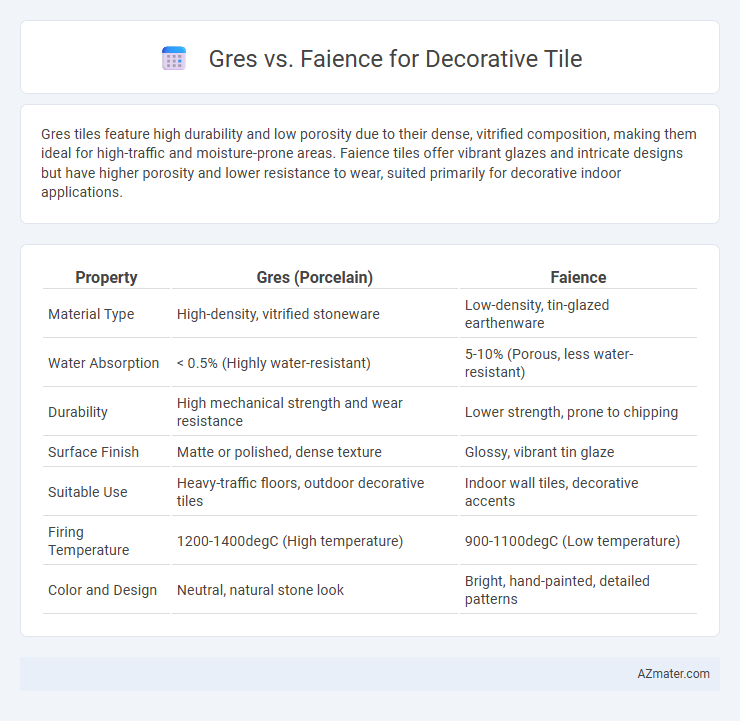Gres tiles feature high durability and low porosity due to their dense, vitrified composition, making them ideal for high-traffic and moisture-prone areas. Faience tiles offer vibrant glazes and intricate designs but have higher porosity and lower resistance to wear, suited primarily for decorative indoor applications.
Table of Comparison
| Property | Gres (Porcelain) | Faience |
|---|---|---|
| Material Type | High-density, vitrified stoneware | Low-density, tin-glazed earthenware |
| Water Absorption | < 0.5% (Highly water-resistant) | 5-10% (Porous, less water-resistant) |
| Durability | High mechanical strength and wear resistance | Lower strength, prone to chipping |
| Surface Finish | Matte or polished, dense texture | Glossy, vibrant tin glaze |
| Suitable Use | Heavy-traffic floors, outdoor decorative tiles | Indoor wall tiles, decorative accents |
| Firing Temperature | 1200-1400degC (High temperature) | 900-1100degC (Low temperature) |
| Color and Design | Neutral, natural stone look | Bright, hand-painted, detailed patterns |
Introduction to Gres and Faience Tiles
Gres tiles, made from fine-grain porcelain or stoneware clay, offer exceptional durability, high resistance to water, and are ideal for both indoor and outdoor decorative applications. Faience tiles, crafted from glazed earthenware, feature vibrant colors and intricate designs, making them popular for artistic and ornamental wall installations. The choice between gres and faience depends on the desired aesthetic, durability needs, and installation environment for decorative tiling projects.
What is Gres Tile?
Gres tile, also known as porcelain stoneware, is a highly durable and dense ceramic tile made from fine-grain clay fired at high temperatures above 1200degC. It features low water absorption, making it suitable for both indoor and outdoor decorative tile applications with excellent resistance to wear, stains, and frost. Gres tiles offer a sleek, modern aesthetic often used in contemporary design projects where longevity and minimal maintenance are desired.
What is Faience Tile?
Faience tile is a type of glazed ceramic tile known for its vibrant colors and glossy finish, traditionally made from fine clay and coated with a tin-based glaze. Unlike gres porcelain tiles characterized by high density and durability, faience tiles offer a decorative appeal with intricate patterns and a more porous structure. Commonly used for wall decorations and artistic designs, faience tiles add aesthetic value but require careful maintenance due to their susceptibility to moisture.
Material Composition Differences
Gres tiles are made from a dense, durable mixture of fine clay and minerals, fired at high temperatures to create a vitrified, moisture-resistant surface ideal for heavy-use areas. Faience tiles consist primarily of a porous earthenware base with a tin-glazed, decorative surface fired at lower temperatures, resulting in a more delicate and decorative finish. The difference in firing temperature and clay composition directly influences gres tiles' strength and faience tiles' ornate appeal, making gres suitable for structural applications and faience preferred for artistic, decorative purposes.
Durability and Performance Comparison
Gres tiles, made from dense, high-fired porcelain, offer superior durability and resistance to wear, making them ideal for high-traffic areas. Faience tiles, typically glazed earthenware, provide vibrant color and intricate designs but are more prone to chipping and moisture absorption. This durability difference positions Gres as the preferred option for long-lasting performance, while Faience excels in decorative appeal.
Aesthetic Appeal and Design Options
Gres tiles offer a sleek, polished finish with subtle color variations that enhance modern and minimalist decor styles, making them ideal for creating elegant, uniform surfaces. Faience tiles stand out for their vibrant glazes and intricate patterns, providing rich textures and bold visual interest perfect for traditional or eclectic interiors. Both materials allow for diverse design options, but faience excels in ornamental detailing while gres emphasizes durability paired with refined aesthetics.
Best Uses: Gres vs Faience in Interior Design
Gres tiles, made from dense, vitrified stoneware, are ideal for high-traffic areas like kitchens and bathrooms due to their durability and water resistance, making them perfect for both flooring and wall cladding. Faience tiles, crafted from glazed earthenware, offer intricate decorative patterns and vibrant colors, best suited for accent walls, backsplashes, and low-moisture interior spaces where aesthetic appeal is prioritized over heavy wear resistance. Choosing between Gres and Faience depends on balancing functional demands with decorative goals in interior design projects.
Cost Considerations
Gres tiles generally offer a higher initial cost compared to faience due to their durability and dense composition, suitable for high-traffic areas and outdoor use. Faience tiles, often glazed and lighter, present a more budget-friendly option primarily for indoor decorative purposes, balancing aesthetics with affordability. Long-term maintenance and replacement costs tend to favor gres tiles, as their resilience reduces the frequency of repair and replacement versus the more fragile faience.
Installation and Maintenance
Gres tiles offer high durability and low porosity, making them ideal for easy installation and minimal maintenance, as they resist stains and moisture effectively. Faience tiles, often glazed and softer, require careful installation with proper sealing to prevent damage and frequent upkeep to maintain their decorative appeal. Choosing Gres ensures a long-lasting surface with simpler cleaning routines compared to the more delicate and maintenance-intensive nature of Faience tiles.
Which Tile is Right for Your Decorative Project?
Gres tiles, known for their high density and durability, are ideal for heavy-traffic areas and outdoor decorative projects due to their resistance to wear and moisture. Faience tiles, made from glazed earthenware, offer vibrant colors and intricate designs perfect for indoor decorative accents and wall applications. Selecting the right tile depends on the project's exposure to elements and desired aesthetic, with Gres providing strength and longevity, while Faience emphasizes artistic elegance.

Infographic: Gres vs Faience for Decorative Tile
 azmater.com
azmater.com